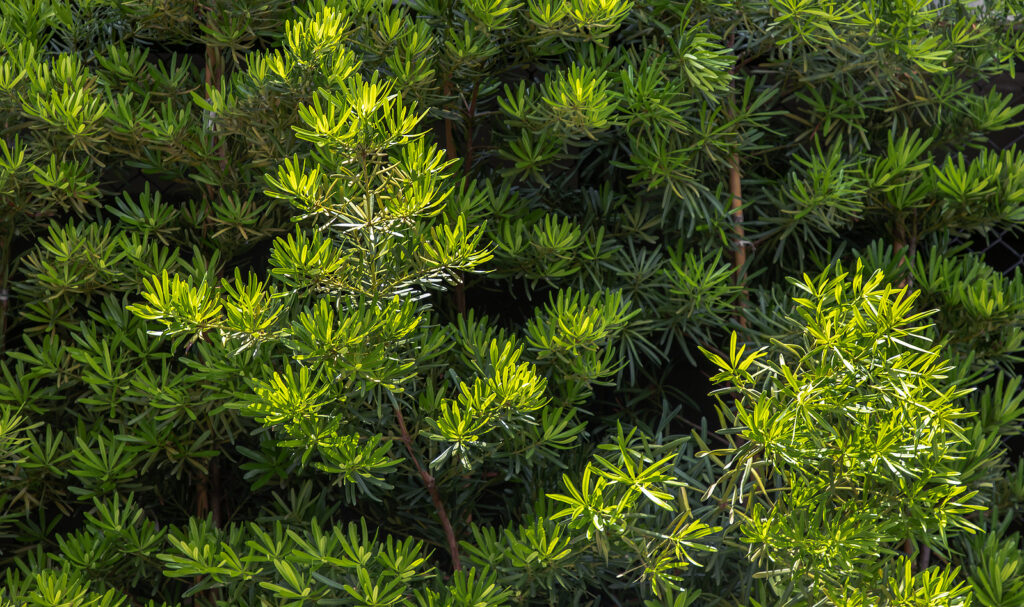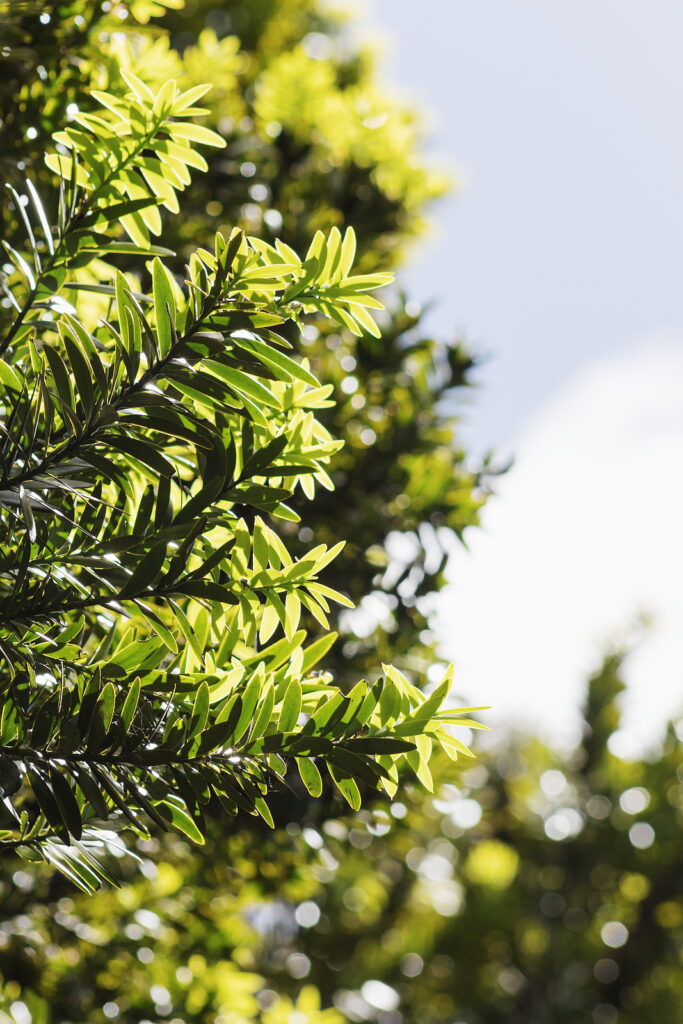Podocarpus — sometimes called Southern Yew–is an evergreen coniferous shrub or tree. It can be grown as a dense hedge or screen or planted as a specimen tree in large gardens. Podocarpus bears deep green needle-like leaves arranged spirally around the stems.
Podocarpus can be pruned to a columnar shape and kept to hedge height or it can allowed to mature to pyramidal shape. Podocarpus is related to yews (Taxus) the leaves are longer and broader and lighter green colored than yews.
Podocarpus is adaptable to many climates and grows well in most soils. Where Podocarpus is not hardy, it can be grown year-round as a greenhouse plant.
Podocarpus is a genus of about 100 species of evergreen, coniferous trees and shrubs.

Get to know Podocarpus
- Plant type: Evergreen tree or shrub
- Growing zones and range: Zones 4 to 9
- Hardiness: Hardy to Zone 4
- Height and width: Typically 8 to 25 feet (2.4-7.6m); podocarpus can grow 50 feet (15m) or more
- Growth rate: Slow
- Form and habit: Columnar or upright oval
- Foliage: Needlelike leaves grow to .8 inch (2cm) wide, 2-4 inches (5.1-102cm) or longer, lustrous dark green above with two whitish bands on the underside
- Flowers: Catkinlike male flowers; female flower is a short stalk bearing a few scales
- Fruits: to .5 inch (1.3cm) long, egg-shaped, reddish-purple; edible
- Bloom time: Midspring
- Uses: Hedge, screening, specimen, seashore border
- Common name: Southern Yew
- Botanical name: Podocarpus
- Family name: Podocarpaceae
- Origin: Forests of warm-temperate and tropical zones
Where to plant Podocarpus
- Plant Podocarpus in full sun or light shade.
- Plant Podocarpus in humus-rich, well-drained, fertile soil; Podocarpus tolerates sandy loam or clay.
- Podocarpus tolerates heat and salt spray but not wet or alkaline soil.
- Podocarpus stem tips may winterkill in sunny, windy sites in Zone 8.
When to plant Podocarpus
- A container-grown Podocarpus transplants easily in fall or early spring.
- Sow seeds in containers in spring.

Planting and spacing Podocarpus
- Space Podocarpus 8 to 25 feet (2.4-7.6m) apart depending on how it’s used in the landscape; plant close together if growing Podocarpus as a hedge or screen.
How to water and feed Podocarpus
- Give Podocarpus regular to moderate water.
- Podocarpus tolerates drought when established but not wet feet.
- Feed Podocarpus with an all-purpose organic fertilizer in spring.
How to prune and care for Podocarpus
- Pruning season for Podocarpus is after growth is complete in summer.
- To train Podocarpus to an informal hedge, prune the plants hard before mid-summer to encourage low branching so that new growth has time to harden before winter.
- If it is necessary to clip twice during the growing season to keep the plants shapely, make the first cut in late spring and the second in mid-summer.
Growing Podocarpus as a houseplant
- Podocarpus macrophyllus var. maki is suitable for indoor growing.
- The optimal temperature for growing Podocarpus indoors is 50° to 60°F (10°-16°C).
- Give Podocarpus bright light or grow it under fluorescent light.
- Allow the soil to dry moderately between thorough waterings.
- Fertilize Podocarpus twice a year, once in spring and once n summer.
- Repot Podocarpus when it outgrows its container; use an all-purpose potting mix.
Podocarpus pests and diseases
- Podocarpus is usually pest-free.
- Podocarpus may develop chlorosis where the soil is alkaline or heavy and damp.
Podocarpus propagation
- Sow seed as soon as ripe or in containers in spring; germination can take 12 to 18 months.
- Take semi-ripe cuttings from upright leading shoots in late summer.
Podocarpus varieties to grow
- P. gracilior, African fern pine, a graceful midsize conifer with fernlike foliage on pendant branches, creates a soft beautiful canopy. It can reach 50 feet (15.2m). Among the cleanest, most pest-free trees for street, lawn, patio, garden; good hedge, big shrub, container plant. Method of propagation determines growth habit. Plants grown from seed are upright when young, with 2-4 inches (5.1-10.2cm) long leaves, .5 inch (1.3cm) wide, glossy dark green leaves somewhat sparsely set on branches. Plants grown from cuttings or grafts of a mature tree retain the small, closely set leaves, but they have very limber branches and are often reluctant to produce strong vertical growth. These more willowy plants, suitable for espalier or growing as vines along fences, are often sold as P. elongatus types eventually become upright trees, though their foliage mass persists in drooping for some time.
- P. henkelii, Long-leafed yellowwood, tree, reaches 20-25 feet (6.1-7.6m) tall, produces drooping tufts of long, narrow, glossy deep green leaves on erect branches.
- P. macrophyllus, Yew Pine, Ye Podocarpus, a rather rigid, upright evergreen 8-25 feet (2.4-7.6m) tall. Has needlelike dark green leaves and scalelike flowers that are followed in fall by edible berrylike reddish-purple fruits. Southern Yew belongs to a group of coniferous shrubs and small trees native to the Southern Hemisphere and to tropical mountains and highlands. Male and female flowers appear on separate plants in early summer; the male flowers grow in catkinlike clusters and female flowers are solitary. The species tolerates salt spray and is planted along the coast and inland for sheared hedges and screening in Zones 8-10 or 11, from North Carolina and southward, and in California.
- P. nagi, (Nageia nagi), tree. Slow growth to 15-20 feet (4.6-6.1m) (80-90 feet (24.4-27.4m) in its native Japan). Branchlets drooping, sometimes for a considerable length. Leaves 1-3 inches (2.5-7.6cm) long, .5-1.5 inches (1.3-3.8cm) wide, leathery, smooth, sharp-pointed. More treelike in youth than other species. Makes decorative foliage pattern against natural wood or masonry. Plant in groves for slender sapling effect. Excellent container plant.
- P. m var. maki, Chinese podocarpus, a narrow shrubby form that grows slowly to 10 feet (3.1m), makes a handsome, compact, dark green hedge; it also does well in containers. In the North, young potted plants are grown indoors and on patios.















